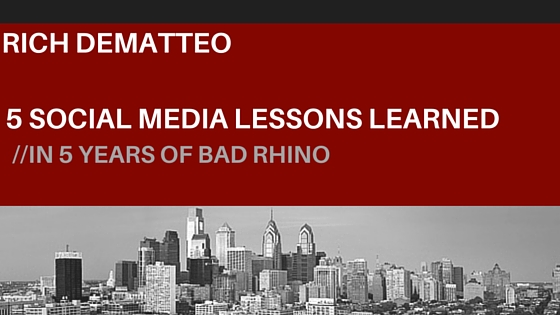I don’t know if you knew this or not, but Bad Rhino social media celebrated 5 years (officially, but t’s actually closer to 7…but who’s counting?) in April 2016. We appreciate your gifts of expensive scotch, chocolates, and Tesla’s to celebrate our milestone and we understand if yours is still in the mail.
As we’ve hit the mark and I look at how much has changed, I wanted to share 5 important lessons that we’ve learned as social media has changed over the years.
Lesson 1: Content is King, but Advertising is his Queen
Behind every good man is a great woman. Behind every great piece of social content, is a paid ad, targeted towards the right community.
Let’s all pretend that Facebook’s four letter word, “reach” (I know it’s 5) didn’t exist. Let’s just say that our organic reach wasn’t reduced. There’s still a hell of a lot of over crowding happening in the social universe. Naturally, your content wouldn’t be seen as much. Now add on the algorithm changes to reduce the number of people seeing content.
While you’ll always have that one post each month that performs incredible on it’s own, most of your best pieces of content should always have paid ads behind them. A little nudge can go a long way.
Lesson 2: Social Media is Your Glue
So many business owners believe that social media is a quick fix and sales will come within the first couple weeks. What Marty once said is that, “Social Media is the glue that holds your marketing together”. So, if your marketing is shit, then social media is just holding your crappy marketing together.
For social media to be effective, you must first ensure your website will convert. Then you need to work on your brand, your story, and your products. Social Media won’t ever fix a crappy product that won’t convert on a really awful website.
What social media will do is help you get your message out quicker, and sell your awesome product or service on your great website.
Lesson 3: Consistency is Key
If your plan is to tweet 5 times a day, then tweet 5 times a day. You won’t be able to tell if it’s working or not for at least 30 days (more like 60 days), so remain consistent. If your plan is to measure your results weekly, then measure your results every week, and take a look at the same metrics every time.
Social media is a bit like understanding your body and losing weight. Whenever you change up your plan, or flat out stop, it’s harder to keep track of what has worked and hasn’t worked and your data is almost unusable. Consistency should be your focus, even when you’re not sure if it’s working or not.
Lesson 4: Get Visual AF
There was a time in 2013, 2014, and early 2015 where sometimes a basic tweet or Facebook post without a picture, video, etc, could perform stronger than images with graphics.
That time has come and gone.
Everything we’re seeing now shows that posts that include some sort of image/video receives much higher reach/impressions, as well as stronger engagement.
This doesn’t mean you have to abandon all graphic-less posts, but use sparingly.
Lesson 5: A Social Media Audit is Key for Building a Strategy
One of the biggest mistakes you can make is jumping in without taking a look around first. Performing an audit on your current marketing and that of competitors (or similar companies) should be your first step.
Choose 2 or 3 companies in your industry that you feel like you can either learn from or model after. Here are some of the questions to ask on your audit:
- What are they doing right on their social channels?
- What are they doing wrong?
- What kinds of content produces the biggest results?
- Are they engaging with their audience?
- Have they tried any contests?
- How do they work their blog/website into social content?
- Which pieces of content are they driving traffic towards?
Using all of this data you can start to build a content strategy that’s unique and targeted. You can also start to get realistic on what’s attainable. For example, we hear so often from clients that they want their Facebook post to have 100 shares, because company XYZ has 100 shares. Once we take a look at company XYZ, we see that they have 500,000 “likes” on their page and it’s clear they’re spending significant money on post advertising. If you’re getting 10 shares, with only 500-1000 “likes” on your page, then comparably you’re doing just as well, if not better than your competitor.
Once you’ve completed your audit and your strategy is underway, it’s not a bad idea to run another audit in about a year to see what has changed and where you can improve.


